Christopher J. Starbuck
Department of Horticulture
Well-known trees provide the shade, framing, screening or background needed in most home landscapes. However, many gardeners want to accent their landscapes with something more unusual. Such plants may serve as conversation pieces or provide a means of testing a person's creativity. Like distinctive art or furnishings, uncommon or unusual plants help to make a landscape a personal expression of the designer.
Uncommon trees may not only be rare; they may provide different shapes, leaf colors or leaf textures (Figure 1). Forms may be weeping, twisted, broad or vertical, while foliage may be variegated in white, pink or other colors. Some provide unusual flowers, or may flower at uncommon times. Like the most popular plants, they may also provide food for birds or other animals.
Whatever the reason for selecting one or more of these uncommon landscape trees, this publication is intended to provide brief descriptions of some that have a good chance for survival in the Missouri climate. Uncommon cultivars of common plants such as 'Flamingo' boxelder or corkscrew willow are not included. Hardiness zones are listed to indicate those trees that may be most suitable for only the warmer areas of the state.
Trees included in this list are not regularly available from all local sources. While you should try first to buy plants locally, the most uncommon might have to be ordered from specialty nurseries. With persistence, most of them can be found in nurseries or garden centers, or purchased from mail-order nurseries.
The approximate mature height is given with each listing, although in some cases plants of these less common types are slow growing and may have their maximum use at much smaller sizes. The plant hardiness zone or zone range also is included, since some of these plants need protected locations or special attention in colder areas, or are not hardy throughout the entire state. Botanical names also are given, since common names are not always accurate.
Amur corktree (Phellodendron amurense)
Large trees for shade or specimen
- 30 to 45 feet
- Zones 3 to 7
The Amur corktree is a slow-growing, spreading tree. The trunk and large branches are ridged and furrowed to give a corklike appearance. Leaves are dark, glossy green and change to yellow or bronze in fall. White flowers are fairly inconspicuous but are followed by clusters of berries that change from green to black. These are produced only on female trees. This tree is easily transplanted and tolerates a wide range of soils and conditions. It has no serious insect or disease problems.
American hornbeam (Carpinus caroliniana)
Large trees for shade or specimen
- 20 to 30 feet
- Zones 2 to 9
Fairly uncommon due to transplanting difficulty. Best for moist, rich acid soils, but suitable for other sites. An understory tree that benefits from shade during hot weather. Can be grown multistemmed or single-stemmed. Slow-growing with grayish bark and muscular-appearing trunk and branches leading to another common name, "musclewood." Dark green leaves turn to yellow or orange in fall. A few pests, but none are a serious problem. A possible choice in areas subject to flooding or extended wet periods with poor drainage.
Asian white birch (Betula platyphylla japonica)
Large trees for shade or specimen
- 30 to 40 feet
- Zones 4 to 6
This white birch, particularly the cultivar 'Whitespire,' is stated to be the most borer-resistant white-barked birch. Where bronze birch borers have been a problem and where a white-barked birch is needed, it should be considered. The branches are thin and spreading with a fairly upright, somewhat pyramidal shape. Not totally resistant to borers, and although an improvement over European white birch, it should not be used in large numbers in a landscape.
Chinese date (Zizyphus jujube)
Large trees for shade or specimen
- 25 to 30 feet
- Zones 6 to 8
This plant is also sometimes known as common Jujube and produces a datelike fruit about an inch long. It is not especially ornamental, with rather open branches. However, it has glossy green leaves and is essentially pest-free, which, combined with its unusual fruit, make it an interesting plant for certain sites. This plant is extremely tolerant of heat and drought. In most of the state, however, it is subject to winter damage as temperatures approach 0 degrees Fahrenheit or colder.
Chinese elm (Ulmus parvifolia)
Large trees for shade or specimen
- 40 to 50 feet
- Zones 4 to 9
The common name of this tree is often confused with that of the Siberian elm (Ulmus pumila), which is a much poorer tree. The bark of this tree becomes mottled with age, giving it a very attractive appearance and another common name, Lacebark elm. It is one of the best elms for landscape and urban planting. It has good resistance to Dutch elm disease and to problem insects such as the elm leaf beetle, which often defoliates the Siberian elm. Leaf color is dark green on trees that become broad and round-headed with age. It tolerates a wide range of soil types and climates.
Cucumbertree magnolia (Magnolia acuminata)
Large trees for shade or specimen
- 50 to 60 feet
- Zones 3 to 8
This large tree needs space and is best used in large landscapes, parks or other open areas. It should be in a location where there is adequate moisture. The large leaves give it a somewhat tropical look. Forms a pyramidal shape when young, becoming more oval with age. Flowers are greenish yellow and not especially showy. Somewhat slow to establish and not tolerant of drought. Given a good location, it is an attractive tree that is practically pest-free. Gets its name from the unusual 2- to 3-inch pinkish fruits, which are produced in fall and somewhat resemble cucumbers.
Dawn redwood (Metasequoia glyptostroboides)
Large trees for shade or specimen
- 70 to 80 feet
- Zones 4 to 8
Dawn redwood was believed to be extinct until 1945, when a Chinese botanist discovered some growing in a remote valley in central China. Three years later a botanical expedition obtained seeds from these trees and distributed them to botanical gardens throughout the world. It is a fast-growing pyramidal tree with a tendency to grow late into the season and leaf out early. This sometimes leads to twig die-back under abrupt temperature changes in spring or fall. The loose, feathery, needlelike foliage is attractive and drops quickly in fall. Good, moist soils are preferred, although it is adaptable to many soil conditions. No serious pests are known.
Devil's walking stick (Aralia spinosa)
Large trees for shade or specimen
- 20 feet
- Zones 5 to 9
A small tree with very coarse branches and huge compound leaves. The abundant prickles give it a thorny appearance and can make working around this plant difficult. The large leaves give it a tropical look. Plants develop shoots from the base and can form thickets with time. The summer effect is attractive, but the stems are very coarse-appearing in winter. It is easy to grow in most soils, in sun or partial shade and with little or no care. It has no serious insect or disease problems. Use it for an accent or specimen away from major traffic areas.
European hornbeam (Carpinus betulus)
Large trees for shade or specimen
- 40 feet
- Zones 4 to 7
Hornbeam is a slow-growing pyramidal tree while young; it is rounded at maturity. Light gray bark covers its smoothly ridged or flattened trunk. Delicate elmlike leaves and a dense branching habit characterize the tree. The seeds are borne in hanging clusters of leaflike bracts. Several improved cultivars of hornbeam include fairly upright growing forms named 'Columnaris' and 'Fastigiata.' Hornbeam is somewhat difficult to transplant and is better established as a smaller tree. However, once established it is an excellent tree that is relatively pest-free.
Golden larch (Pseudolarix kaempferi)
Large trees for shade or specimen
- 30 to 40 feet
- Zones 4 to 7
This broadly pyramidal tree has needles that drop in fall, which makes it unusual. Horizontal branches bear tufted needles that turn yellow in the fall before they drop. Summer leaves are light green in color. Fairly open, very slow growing tree. Needs full sun or light shade and tolerates many soil types that are somewhat acid. No serious disease or insect pests are known.
Hardy rubber tree (Eucommia ulmoides)
Large trees for shade or specimen
- 40 to 60 feet.
- Zones 5 to 7
Attractive, shiny, dark green leaves on a broad, round-headed tree. No fall color of foliage. Easy to grow in many soil types but needs full sun. A very drought-tolerant tree once established. Essentially free of insect and disease problems. The most hardy of rubber-producing trees, but subject to some damage during severe winters.
Hophornbeam, ironwood (Ostrya virginiana)
Large trees for shade or specimen
- 25 to 35 feet
- Zones 3 to 9
Branches of this small, broad-spreading tree are fairly horizontal and may be slightly drooping. The tree is somewhat upright when young but becomes broad with age. Leaves are dark green in summer and become yellow in fall. It prefers cool, moist soil but tolerates a wide range of conditions. It can be grown in full sun or partial shade. Other related species that may sometimes be available include the Japanese hophornbeam (Ostrya japonica) and the European hophornbeam (Ostrya carpinifolia). These have no serious insect or disease pests.
Japanese raisintree (Hovenia dulcis)
Large trees for shade or specimen
- 30 feet.
- Zones 6 to 8
This small tree develops into an oval form with attractive, fairly large leaves. It is well adapted to many soil types and conditions. Its hardiness is a problem in colder areas, and it is particularly sensitive to rapid temperature changes. Although very durable, die-back often occurs in colder areas after severe winters. The flower structure contains fleshy branches that are sweet and can be chewed as they mature in late summer and early fall. No serious pest problems.
Katsuratree (Cercidiphyllum japonicum)
Large trees for shade or specimen
- 40 feet
- Zones 4 to 8
This excellent and attractive tree develops into a round-headed shade tree. New leaves that are similar in shape to redbud have a reddish purple color that changes to medium green in summer. Fall color is yellow. It is somewhat slow to establish after transplanting but a medium-fast grower once established. It is highly adaptable to soil and environment but should be given water during drought periods until it is well established. This tree is essentially free of pests, but the bark of young trees is subject to sun scald and should be protected during the first years.
Nikko maple (Acer nikoense)
Large trees for shade or specimen
- 20 to 30 feet
- Zones 5 to 6
This slow-growing tree develops into a round head. It is excellent where shade is needed in small spaces. The trifoliate leaves are bronze in spring and change to medium green in summer. Fall color is yellow or reddish purple. Grows best in slightly acid loam soils that have adequate moisture but are well-drained.
Paperbark maple (Acer griseum)
Large trees for shade or specimen
- 25 feet
- Zones 4 to 7
This small, round-headed tree has fairly open branching. The bark peels off in paperlike strips to expose a bright copper-colored bark beneath. This provides interesting winter color, but this effect is primarily in the younger branches. The compound leaves resemble boxelder and have no special ornamental value. Paperbark maple is best used as a lawn specimen tree where it is most visible in winter. It tolerates a wide range of soils and exposures.
Persian parrotia (Parrotia persica)
Large trees for shade or specimen
- 20 to 40 feet
- Zones 4 to 8
This wide-spreading, rounded tree often is grown with several trunks from the base. It is a relative of witchhazels and its leaves are similar. The bark of older branches and trunks exfoliates, exposing gray, brown, green and white patches, which make this tree unusual and interesting in winter. Foliage is reddish purple when young, becoming dark green in summer and yellow to orange in fall. Best in slightly acid soils and a location with good drainage in full sun. Tolerant of many climates and conditions once established.
Pond cypress (Taxodium distichum nutans)
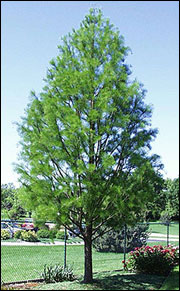 Large trees for shade or specimen
Large trees for shade or specimen
- 70 to 80 feet
- Zones 4 to 9
This type of bald cypress was once botanically classified as Taxodium ascendens and may sometimes still be listed under its former name. It tolerates wet conditions and can be grown in the same conditions as common bald cypress. This alternate form is much more erect and narrow-growing. Foliage is very fine, giving the tree a thin, open appearance. It is easy to transplant and grow in moist, sunny locations. While it can be grown in swampy soils, it is also suitable for drier, upland conditions. This tree is difficult to find but makes an unusual specimen when available. The cultivar 'Prairie Sentinal' is upright, reaching a width of about 10 feet.
Sycamore maple (Acer pseudoplatanus)
Large trees for shade or specimen
- 40 to 60 feet
- Zones 4 to 7
This tree, which is abundant throughout Europe, is sometimes confused with sycamore, or planetree, but is a true maple. It develops an oval shape with spreading branches. Leaves are dark green in summer without fall color. It tolerates many soil types, but leaves scorch easily under the heat and drought of Midwestern summers. Therefore, summer watering is important during drought periods. Except for its novelty and rarity as a Midwestern tree, it has little to offer for the Missouri climate. While it is almost a weed tree in northern Europe, other maples are better choices for major plantings in Missouri.
Western soapberry (Sapindus drummondii)
Large trees for shade or specimen
- 20 to 30 feet
- Zones 6 to 9
This is a durable tree for dry sites and is easily transplanted and adapted to many soil types. The pinnately compound leaves are glossy green in summer and turn a yellow-gold in fall. The fruit is yellow-orange and remains on the tree all winter, finally turning black. It seeds readily, so seedlings may become a slight weed problem. This tree has strong wood, making it particularly suited for areas with frequent strong storms. It also is very drought tolerant, which makes it suitable for dry sites. However, wet low areas should be avoided. This tree has possibilities for use in urban sites with pollution problems, but fruits can be messy if used near walks or patios. No serious pests.
Zelkova (Zelkova serrata)
Large trees for shade or specimen
- 50 feet
- Zones 5 to 8
Sometimes called Japanese Zelkova, this tree was once considered a replacement for the American elm because it is a relative that grows with a similar shape. It has good resistance to Dutch elm disease. Trees develop a basic vase shape but do not grow as rapidly as the American elm. The leaves are dark green with a medium-fine texture. This tree is fairly easy to transplant and grow and is wind and drought tolerant. It grows best in deep soils and may be much slower in shallow, rocky soils. The insect pests of elm may attack it, but it tolerates them well.
Amur maackia (Maackia amurensis)
Medium to small trees for flowering or other distinctive accent
- 20 to 30 feet
- Zones 3 to 7
This small tree develops into a round-headed tree at maturity. The leaves are compound and dark green in summer. Its most unusual characteristic is white flowers that are produced in summer, normally in June or July. The flowers are small but numerous and give the tree a distinctive showy appearance when few other trees are flowering. It is definitely a tree to use for a specimen. It is adaptable to many locations but is best in well-drained soils with a sunny exposure. It does not appear to have any serious insect or disease problems.
Blackhaw viburnum (Viburnum prunifolium)
Medium to small trees for flowering or other distinctive accent
- 15 to 25 feet
- Zones 3 to 8
It may seem strange to list a native tree with a group of unusual plants, but this attractive small tree is uncommon in landscapes. The leaves are glossy and dark green, which makes them attractive throughout the season. In fall they develop a deep red to purplish color. The tree is round-headed or can be grown with multiple stems as a small tree or large shrub. Clusters of small, white flowers are attractive in late spring, but the fruits that form in late summer are attractive and much liked by birds. Fruits turn from pinkish to rose and then to blue-black. The tree has no serious insect or disease problems and is adaptable to many conditions, including drought and poor soils. Another common name for the tree is "possum haw," because fruits are also liked by possums and the round-headed trees resemble hawthorns.
Carolina silverbell (Halesia carolina)
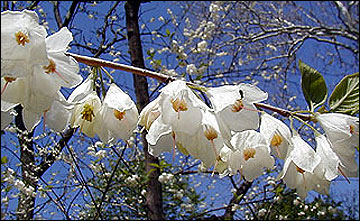 Medium to small trees for flowering or other distinctive accent
Medium to small trees for flowering or other distinctive accent
- 25 to 30 feet
- Zones 6 to 8
A beautiful flowering tree that may suffer in colder climates subject to rapid temperature changes. In colder areas, it should be placed in a somewhat protected location. It needs well-drained, rich acid soil and is a good companion tree in areas suitable for azaleas and rhododendrons in the landscape. It can tolerate some shade and needs water during drought periods. Its most attractive feature is the white bell-shaped flowers that are produced abundantly in spring. Flowers hang like bells, but they are effective for only about one week. This understory tree needs afternoon shade in the Missouri climate. It has no serious disease or insect pests, but should not be planted in poorly drained or wet areas where root damage may occur.
Chinese witchhazel (Hamamelis mollis)
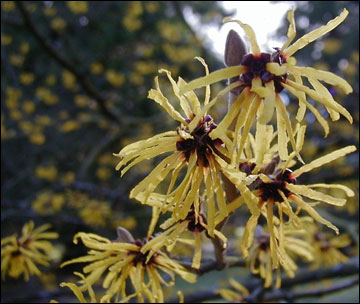 Medium to small trees for flowering or other distinctive accent
Medium to small trees for flowering or other distinctive accent
- 10 to 15 feet
- Zones 5 to 8
More frequently thought of as a large shrub, this plant may also develop a treelike form. It is most useful for its yellow flowers, which are produced in February or March or sometimes earlier during a warm spell in winter. It is a close relative to our native witchhazel, but the plant is smaller and the flowers are more showy. As a tree, it becomes rounded in form and may be as broad as it is tall. The bark is smooth and gray, making it attractive in winter. This tree grows best in rich acid soils. It is an understory plant and should be grown in light shade. Although not a showy plant, it is useful for its unusual early flowering. There are no serious pest problems of witchhazel. Hybrids of this witchhazel with Japanese witchhazel (Hamamelis x intermedia), may be grown as either large shrubs or small trees and should be considered as interesting landscape specimens.
European filbert (Corylus avellana)
Medium to small trees for flowering or other distinctive accent
- 12 to 20 feet
- Zones 4 to 7
The filberts are more commonly considered large shrubs but might be grown as small trees. However, they usually produce extensive shoots from the roots, which must be removed to maintain a small tree form. Leaves are large, giving plants a coarse texture. The long male catkins add interest in early spring. The shrubby form of this plant with twisted branches called Harry Lauder's Walkingstick is often planted as a novelty because of its curled and twisted branches.
Franklinia (Franklinia alatamaha)
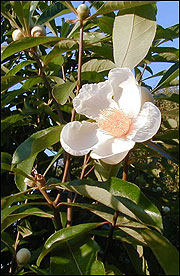 Medium to small trees for flowering or other distinctive accent
Medium to small trees for flowering or other distinctive accent
- 10 to 20 feet
- Zones 5 to 8
A difficult plant for Missouri's climate, Franklinia is somewhat difficult to transplant and should be purchased as a small container or balled-and-burlapped plant. Franklinia was first discovered in Georgia; no plant has been found in the wild since 1790. All trees growing today are descendants of those grown from seeds collected at that time. The plant needs moist acid soils high in organic matter. It is best in light shade during the heat of the day and must be watered during drought periods. It is a slow-growing small tree or large shrub noted for its large white flowers in late summer. The foliage turns orange to red in the fall, often while the plant is still in bloom. No serious pests of Franklinia have been reported.
Hoptree, wafer ash (Ptelea trifoliata)
Medium to small trees for flowering or other distinctive accent
- 15 to 20 feet
- Zones 3 to 9
This small tree may also be grown as a large shrub. It is a durable plant for use in light shade as an understory tree in woodlands. It needs good drainage, but does best in moist woodlands. It can also be grown in full sun. The flowers are not showy, but the flattened, broadly winged fruits are showy from late summer into December and sometimes longer. Leaves are trifoliate, glossy and dark green, giving them a look something like poison ivy but without any danger of sensitivity. A native plant that could be used more in landscapes when available.
Japanese snowbell (Styrax japonicus)
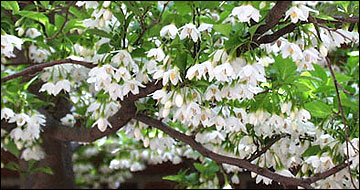 Medium to small trees for flowering or other distinctive accent
Medium to small trees for flowering or other distinctive accent
- 20 feet
- Zones 5 to 7
This plant develops into a small, low-branched tree that is often wider than it is tall. Graceful, small, waxy white flowers hang from the curving horizontal branches in late spring or early summer. Flowers appear after the leaves are fully developed, but the leaves are arranged on the upper side of the branches so the pendulous flowers are clearly evident below. The dark green leaves, wide-spreading growth habit and flowers make this an outstanding specimen tree. It needs rich soil and adequate summer moisture. In colder climates it may need some winter protection. It can be grown in full sun or light shade. No serious pests are known.
Japanese tree lilac (Syringa reticulata)
Medium to small trees for flowering or other distinctive accent
- 25 feet
- Zones 3 to 7
This plant makes an excellent specimen tree with rounded form and spreading growth. Large clusters of very fragrant white flowers appear about mid-June, or about 4 to 6 weeks after common lilac. The odor is not like common lilac but more like privit, which is a close relative. The bark is reddish brown with a cherrylike quality that is attractive in winter. It tolerates a wide range of climatic and soil conditions. Unfortunately, it is subject to all the pests that may attack common lilac, so lilac borer and several lilac diseases may attack it. Despite this problem, it is still probably the toughest of the lilacs. A close relative, the Pekin lilac (Syringa pekinensis), is similar and also worth considering when available.
Korean evodia (Evodia daniellii)
Medium to small trees for flowering or other distinctive accent
- 25 to 30 feet
- Zones 4 to 8
This small tree offers excellent foliage, flowers and fruits. Leaves are a lustrous dark green. Flowers are small and white in flattened clusters that appear in June, July or August, depending on locality, when few other trees flower. Attractive fruits follow the flowers, which are red and split open to show shiny black seeds. These structures add landscape interest from about September to November. This plant is adaptable to many conditions but is best in moist, fertile soil in full sun. The wood is somewhat brittle, but no serious pests are known.
Pawpaw (Asimina triloba)
Medium to small trees for flowering or other distinctive accent
- 15 to 20 feet
- Zones 5 to 8
Hardly considered a rare tree since it is native, but uncommon in landscapes. The main reason may be that it is difficult to transplant and should be moved when small. It can be grown as an understory tree in light shade but will also grow in full sun. Leaves are large and may be as much as 12 inches long. Flowers are unusual but not easily seen. The fruits are oval-shaped and are edible, with a taste suggesting banana. Plants grow best in moist, deep soils and often are found near streams, but they also will thrive in drier sites. The fruits usually are not abundant and animals eat them quickly. Nevertheless, plants should not be used where fruits may fall on walks or patios.
Red buckeye (Aesculus pavia)
 Medium to small trees for flowering or other distinctive accent
Medium to small trees for flowering or other distinctive accent
- 15 to 25 feet
- Zones 4 to 8
Red buckeye can be grown as a small tree or a multistemmed large shrub. The small trees are somewhat round-topped and become as broad as they are tall. The upright panicles of red flowers may be 3 to 6 inches long and are quite attractive in late April or early May. The plant is fairly easy to grow once established, but is fairly slow growing. Leaves are fairly large in five leaflets. They do not have a distinctive fall color and drop early. The lustrous brown seeds produced in fall must be planted promptly for production of additional plants. Trees will grow in light shade or full sun.
Siberian peatree (Caragana arborescens)
Medium to small trees for flowering or other distinctive accent
- 15 to 20 feet
- Zones 2 to 7
This plant is often called peashrub and can be grown in a shrubby form. It is easy to grow and very cold-hardy. Because it is a legume that can fix nitrogen from the air, it is tolerant of poor soils, pH, high salts and other difficult conditions. Peatree requires soil with excellent drainage. The plant is more erect than spreading and forms a fairly low, open plant with sparse branching. Pea-shaped yellow flowers are produced in May. Leaves are compound with small leaflets that give a ferny appearance. A weeping form, 'Pendula,' makes an interesting small specimen. Caragana is not the most attractive plant that might be used, but it provides a unique appearance in an area not suited to many other plants in full sun. It has no serious pest problems.
Sourwood (Oxydendrum arboreum)
Medium to small trees for flowering or other distinctive accent
- 20 to 30 feet
- Zones 5 to 9
Sourwood is a slow-growing pyramidal tree with lustrous, leathery foliage. The drooping panicles of white flowers are produced in midsummer. The brilliant scarlet autumn color is one of the most vivid fall colors in any tree species. The yellowish fruit capsules often contrast with the fall color, but gradually turn brown late in the season. This plant is difficult to transplant and must be planted balled-and-burlapped into acid, moist, well-drained soil high in organic matter. It is best in light shade, particularly during the heat of summer. Although sourwood can tolerate dry soils, it needs irrigation during drought periods, particularly when accompanied by high temperatures. Leaf spots can attack foliage, but there are no other serious pests. An excellent tree, but fairly difficult in the Missouri climate.
Stewartia (Stewartia pseudocamellia)
Medium to small trees for flowering or other distinctive accent
- 15 to 30 feet
- Zones 5 to 7
This Japanese stewartia and a close relative, the Korean stewartia (Stewartia koreana), are similar. Both are useful for landscape plantings. They have an upright growth with medium green leaves that produce excellent reddish purple fall color. White flowers from 2 to 3 inches in diameter are produced in early July, when flowers on trees are quite uncommon. The flowering period is fairly short, however, as flowers last only a single day and soon drop off. Growth is fairly slow, but plants are attractive throughout the season. The bark peels and gives a combination of brown, reddish brown and gray on the trunk of both species. Plants seem to endure erratic winter temperatures well, but need watering during drought periods. Stewartias do not have any serious pest problems.
Weeping mulberry (Morus alba "pendula")
Medium to small trees for flowering or other distinctive accent
- 20 to 30 feet
- Zones 4 to 8
Although the white mulberry is quite common, the weeping forms shift into and out of popularity. Where a relatively fast-growing weeping tree is wanted, weeping mulberry can make a unique accent plant. Several varieties with weeping growth habit are available from some nurseries. These weeping forms are fruitless, which is important as a landscape plant. Leaves are coarse and dark green but abundant. There is no outstanding fall color and the plants have little to offer other than easy growth and weeping form. Mulberries withstand many difficult growing conditions. They are subject to a few insect and disease pests, but they are not normally a serious problem on vigorous trees.
White fringetree (Chionanthus virginicus)
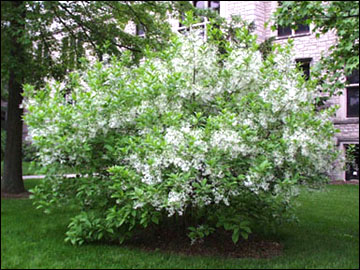 Medium to small trees for flowering or other distinctive accent
Medium to small trees for flowering or other distinctive accent
- 15 to 25 feet
- Zones 3 to 8
This small tree develops into a wide-spreading crown. Both male and female plants are attractive in flower. Male plants may be slightly more attractive in flower, but female plants have attractive dark blue fruits that are attractive in early fall. The plant is somewhat difficult to establish, but very durable once established. It can be grown in light shade or full sun and is tolerant of many conditions and soils. Fall color is usually yellow and showy. No serious pests of this plant are apparent. The long, thin petals of the white flowers are responsible for another common name, old-man's-beard.
Bristlecone pine (Pinus aristata)
Unusual evergreen trees for specimen planting
- 8 to 20 feet
- Zones 4 to 7
This pine has a picturesque growth habit that makes it useful for a single accent plant. The dark green needles are an inch or slightly more in length and in clusters of five. A white resinous substance forms on them. This plant is very slow growing and needs soils with perfect drainage. It adapts well to rocky, poor soils and raised beds or rock gardens. Some plants of this species in eastern Nevada are considered the oldest living plants in the world, with several trees reported to be between 4,000 and 5,000 years old. It is a worthwhile accent plant, but not one for extensive use.
Cedar of Lebanon (Cedrus libani var. stenocoma)
Unusual evergreen trees for specimen planting
- 30 to 50 feet
- Zones 5 to 7
This is considered the most cold-hardy of the true cedars, followed by blue atlas cedar (Cedrus atlantica) for zone 6 and southward and Deodar cedar (Cedrus deodara) for zone 7 and southward. The true cedars are outstanding landscape plants in their proper climates. The stenocoma variety of the cedar of Lebanon is stiffer than the true species, but attractive. The cedar of Lebanon is pyramidal when young but becomes wide-spreading with maturity. This plant needs full sun and deep, well-drained soils. It is subject to winter damage, which may appear as needle burn or die-back, during severe winters. This is a plant for the gardener who wants something unique and is willing to take care of it. It is very slow growing in the Missouri climate but has no serious insect or disease pests.
Concolor fir (Abies concolor)
Unusual evergreen trees for specimen planting
- 25 to 35 feet
- Zones 3 to 7
These trees are conical and branch to the base, giving an appearance similar to a spruce. However, needles curve out and upward from the twigs, and are flattened and bluish or grayish green on both surfaces. This is probably the most successful of the true firs for Missouri landscapes. This fir tolerates heat, drought and cold very well. It needs deep, well-drained soils and is best in full sun or light shade. It has no serious pest problems, and although it is very drought tolerant, it benefits from summer irrigation in its first years after planting. It must not be planted in any poorly drained sites or soils.
Cryptomeria (Cryptomeria japonica)
Unusual evergreen trees for specimen planting
- 40 to 60 feet
- Zones 6 to 8
This tree is fairly slow-growing in Missouri climates and may be subject to winter damage in severe winters. It is an attractive tree with short needles that are bright green. Branchlets are somewhat drooping, giving the plant a graceful appearance. When young it is conical, gradually becoming wide-spreading with age. It is a plant for a protected location shielded from high winds, particularly in winter. It needs full sun and abundant moisture during drought periods of summer. A leaf blight may sometimes be a problem, so it is a plant that is beautiful in the right location and with proper care, but not a plant for every Missouri landscape.
Japanese red pine (Pinus densiflora)
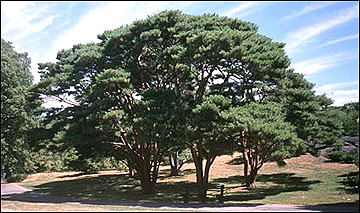 Unusual evergreen trees for specimen planting
Unusual evergreen trees for specimen planting
- 40 to 60 feet
- Zones 3 to 7
Needles of this pine are dark green in bundles of two and may be from 3 to 4 inches long. They are thin, soft and sometimes slightly twisted. This plant makes an interesting specimen because growth is fairly open, trunks often are crooked, branches are horizontal and the plant often develops a unique shape. Severe winters may damage the needles or twigs, but growth buds are seldom damaged. In the forests of Japan, this species is susceptible to pine wilt disease. This species has several interesting varieties for specimen or accent planting. The cultivar 'Umbraculifera,' also known as the Tanyosho pine, is a flat-topped tree that develops an umbrella form in the landscape, growing up to 8 or 9 feet. The dragon's-eye pine, 'Oculus-draconis,' produces needles that are green and yellow. This coloration is most obvious on the needles less than one year old.
Lacebark pine (Pinus bungeana)
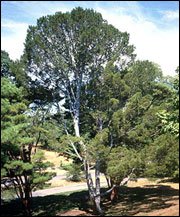 Unusual evergreen trees for specimen planting
Unusual evergreen trees for specimen planting
- 30 to 40 feet
- Zones 4 to 8
This pine has stiff, dark green needles 2 to 3 inches long in bundles of three. In early stages, plants are somewhat pyramidal but gradually become rounded and finally broad-spreading. Growth of this pine is very slow. The plant makes a good specimen, particularly where the bark can be seen. The name comes from the bark, which exfoliates as the plant ages. Stems may have mixed colors of greenish, whitish or brownish irregular patches. The plant needs well-drained soils in a sunny location.
Nootka falsecypress (Chamaecyparis nootkatensis)
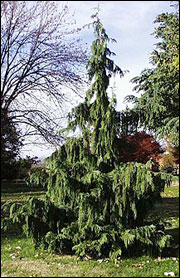 Unusual evergreen trees for specimen planting
Unusual evergreen trees for specimen planting
- 30 to 50 feet
- Zones 4 to 7
Sometimes called the Alaska cedar, this evergreen appears to be one of the best of the large group of Chamaecyparis species that can be used in the landscape. It has good winter hardiness and is relatively pest-free. Growth of the plant is conical, but with pendulous flattened twigs that give it an attractive, graceful appearance. While the plant is relatively tolerant of poor soil and moisture conditions, it benefits from additional water during hot, dry periods. Plants are best for open, sunny locations, but will tolerate some light shade.
Serbian spruce (Picea omorika)
Unusual evergreen trees for specimen planting
- 40 to 50 feet
- Zones 4 to 7
This plant has dense foliage on narrow, pyramidal growth. Soil for the plant should be deep and well drained. It can be grown in semishaded locations and is one of the most adaptable spruces. Several dwarf forms of this plant as well as a drooping form are sometimes available for landscape use. Summer moisture is important for best growth of this slow-growing plant. This is one of the best spruces but subject to some of the insect pests of spruces.
Swiss stone pine (Pinus cembra)
Unusual evergreen trees for specimen planting
- 25 to 30 feet
- Zones 4 to 7
This slow-growing pine forms a dense, pyramidal form. It is fairly narrow when young, but broadens with age. Needles are in bundles of five and are from 2 to 3 inches long and occasionally longer. They are very thin, giving the texture similar to white pine. This pine is fairly easily transplanted and should be used in full sun where soil is well drained and slightly acid.
Umbrella pine (Sciadopitys verticillata)
Unusual evergreen trees for specimen planting
- 15 to 25 feet
- Zones 4 to 7
This unusual evergreen from the pine family is extremely slow growing. The needles are flat leaves that are dark, glossy green and thick. The needles radiate around the stem, which provides the effect that gives the plant its name. It must be planted in rich, moist soil where it gets afternoon shade. Moisture must be maintained during drought periods, but good drainage to prevent excess moisture buildup is important. This unusual small tree takes some pampering in the Missouri climate.